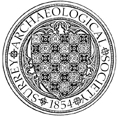The Old Forge, Upper Church Lane, Farnham
Watching brief by D Graham of SyAS. The foundation trenches were filled with concrete prior to the site visit and little evidence of archaeological significance was revealed.

Watching brief by D Graham of SyAS. The foundation trenches were filled with concrete prior to the site visit and little evidence of archaeological significance was revealed.
Watching brief by A Graham of SyAS. Two possible quarry pits of likely 18th/19th century date were revealed.